light TOYOTA C-HR 2020 Warranties & Maintenance Guides (in English)
[x] Cancel search | Manufacturer: TOYOTA, Model Year: 2020, Model line: C-HR, Model: TOYOTA C-HR 2020Pages: 260, PDF Size: 8.54 MB
Page 99 of 260

HANKOOK TIRE
97
Limited Warranty
For Original Equipment Passenger Car & Light
Truck Tires Including Temporary Tires
What Is Covered and for How Long
Hankook warrants that a tire manufactured by Hankook and
equipped originally on the vehicle is free from defects in materials or \
workmanship in normal use for the life of the original usable tread. The
life of the original usable tread ends when the tire tread has been worn\
down with only 1.6mm (2/32nds inch) remaining, at which point the tire
is considered to be fully worn out.
Passenger Car and Light Truck Tiresa.
Free replacement
If Hankook Radial Passenger & Light Truck Tires fail as a result of
defect in material and/or workmanship within the first 25% of tread
wear, the tire will be replaced with a new, comparable Hankook
Tire at no charge including mounting and balancing charges.
b.
Pro rata replacement
Tires not qualifying for free replacement will be allowed a credit
toward purchase of a new, comparable Hankook Tire based
upon the amount of tread actually worn. The cost of mounting,
balancing and any other service charges or applicable taxes shall
be paid by the user. Otherwise adjustment for compensation will
be made on a prorata basis calculated by multiplying the actual
current dealer selling price by the percentage of remaining usable
tread depth.
Hankook Temporary Tire a.
A Temporary tire weighs less and provides more trunk storage
space than a conventional tire. To conserve tire tread life,
temporary tire should be returned to the trunk as soon as it is
convenient to have your standard tire repaired or replaced.
b.
If Hankook Temporary Tire fails as a result of defect in materials
and/or workmanship during the first 50% of usable tread wear,
the tire will be replaced with a new, comparable tire at no charge
Page 102 of 260
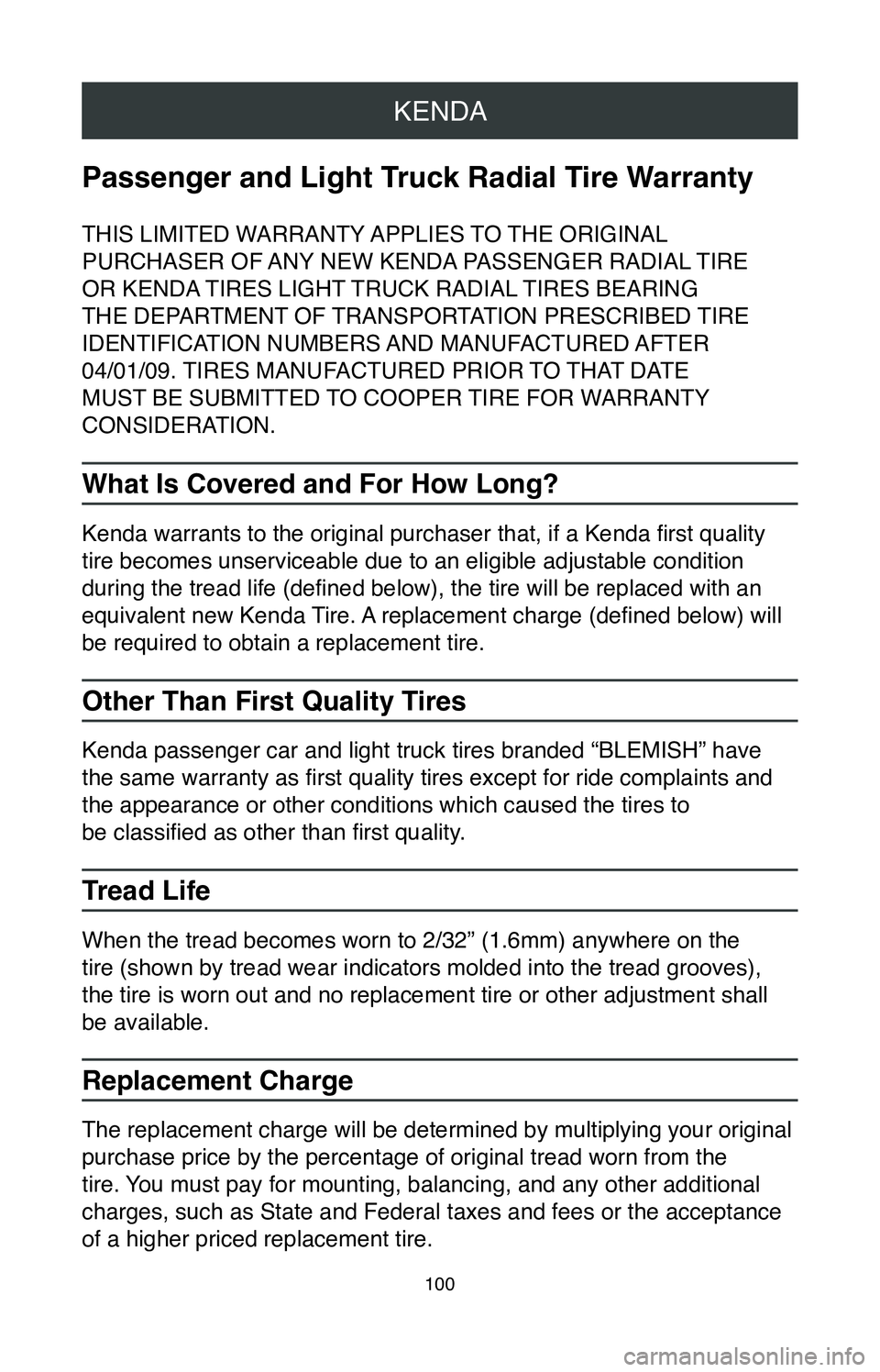
KENDA
100
Passenger and Light Truck Radial Tire Warranty
THIS LIMITED WARRANTY APPLIES TO THE ORIGINAL
PURCHASER OF ANY NEW KENDA PASSENGER RADIAL TIRE
OR KENDA TIRES LIGHT TRUCK RADIAL TIRES BEARING
THE DEPARTMENT OF TRANSPORTATION PRESCRIBED TIRE
IDENTIFICATION NUMBERS AND MANUFACTURED AFTER
04/01/09. TIRES MANUFACTURED PRIOR TO THAT DATE
MUST BE SUBMITTED TO COOPER TIRE FOR WARRANTY
CONSIDERATION.
What Is Covered and For How Long?
Kenda warrants to the original purchaser that, if a Kenda first quality
tire becomes unserviceable due to an eligible adjustable condition
during the tread life (defined below), the tire will be replaced with an
equivalent new Kenda Tire. A replacement charge (defined below) will
be required to obtain a replacement tire.
Other Than First Quality Tires
Kenda passenger car and light truck tires branded “BLEMISH” have
the same warranty as first quality tires except for ride complaints and
the appearance or other conditions which caused the tires to
be classified as other than first quality.
Tread Life
When the tread becomes worn to 2/32” (1.6mm) anywhere on the
tire (shown by tread wear indicators molded into the tread grooves),
the tire is worn out and no replacement tire or other adjustment shall
be available.
Replacement Charge
The replacement charge will be determined by multiplying your original
purchase price by the percentage of original tread worn from the
tire. You must pay for mounting, balancing, and any other additional
charges, such as State and Federal taxes and fees or the acceptance
of a higher priced replacement tire.
Page 113 of 260
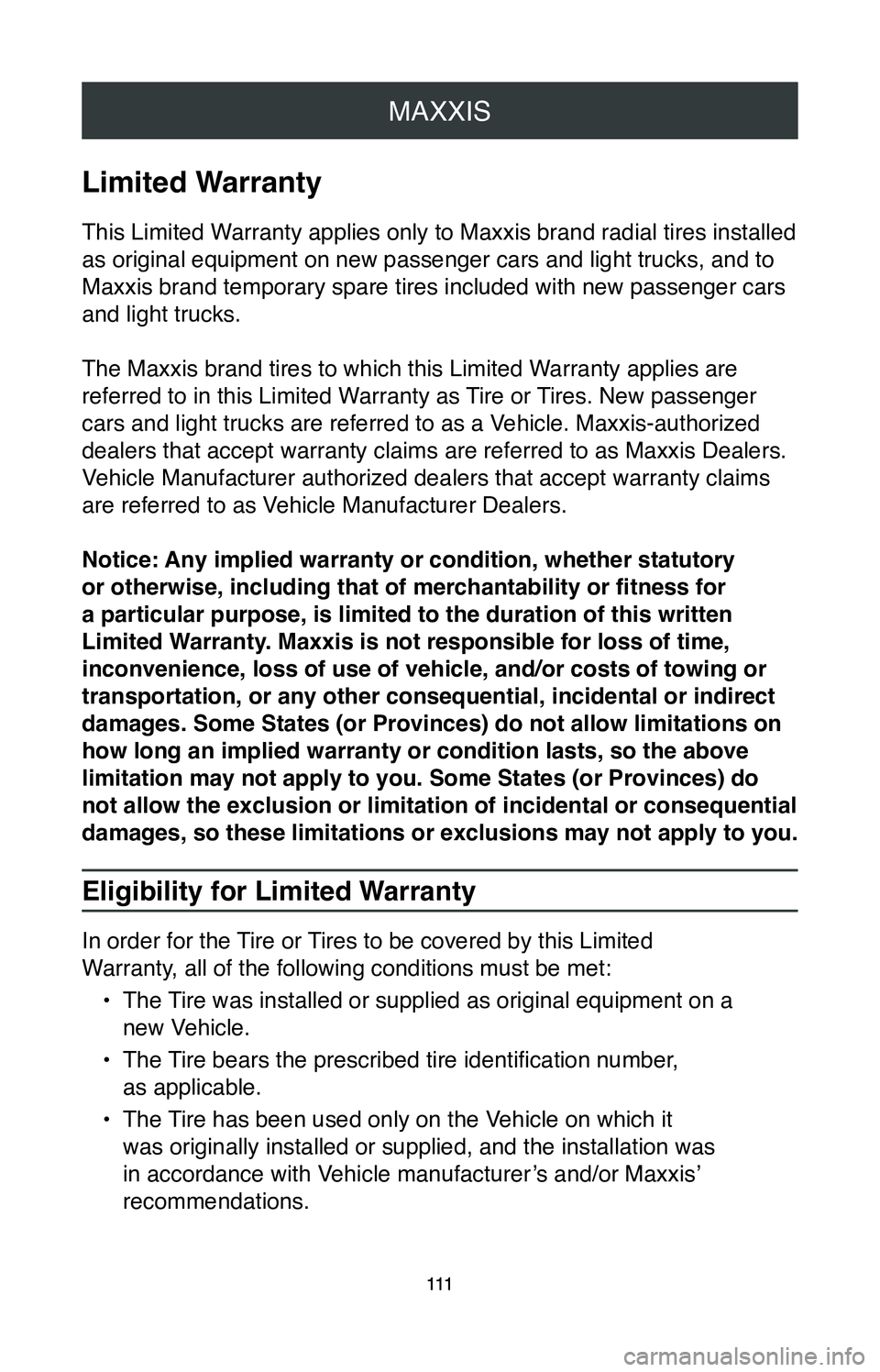
MAXXIS
111
MAXXIS
111
Limited Warranty
This Limited Warranty applies only to Maxxis brand radial tires installed
as original equipment on new passenger cars and light trucks, and to
Maxxis brand temporary spare tires included with new passenger cars
and light trucks.
The Maxxis brand tires to which this Limited Warranty applies are
referred to in this Limited Warranty as Tire or Tires. New passenger
cars and light trucks are referred to as a Vehicle. Maxxis-authorized
dealers that accept warranty claims are referred to as Maxxis Dealers.
Vehicle Manufacturer authorized dealers that accept warranty claims
are referred to as Vehicle Manufacturer Dealers.
Notice: Any implied warranty or condition, whether statutory
or otherwise, including that of merchantability or fitness for
a particular purpose, is limited to the duration of this written
Limited Warranty. Maxxis is not responsible for loss of time,
inconvenience, loss of use of vehicle, and/or costs of towing or
transportation, or any other consequential, incidental or indirect
damages. Some States (or Provinces) do not allow limitations on
how long an implied warranty or condition lasts, so the above
limitation may not apply to you. Some States (or Provinces) do
not allow the exclusion or limitation of incidental or consequential
damages, so these limitations or exclusions may not apply to you.
Eligibility for Limited Warranty
In order for the Tire or Tires to be covered by this Limited
Warranty, all of the following conditions must be met:•
The Tire was installed or supplied as original equipment on a
new Vehicle.
•
The Tire bears the prescribed tire identification number,
as applicable.
•
The Tire has been used only on the Vehicle on which it
was originally installed or supplied, and the installation was
in accordance with Vehicle manufacturer’s and/or Maxxis’
recommendations.
Page 119 of 260
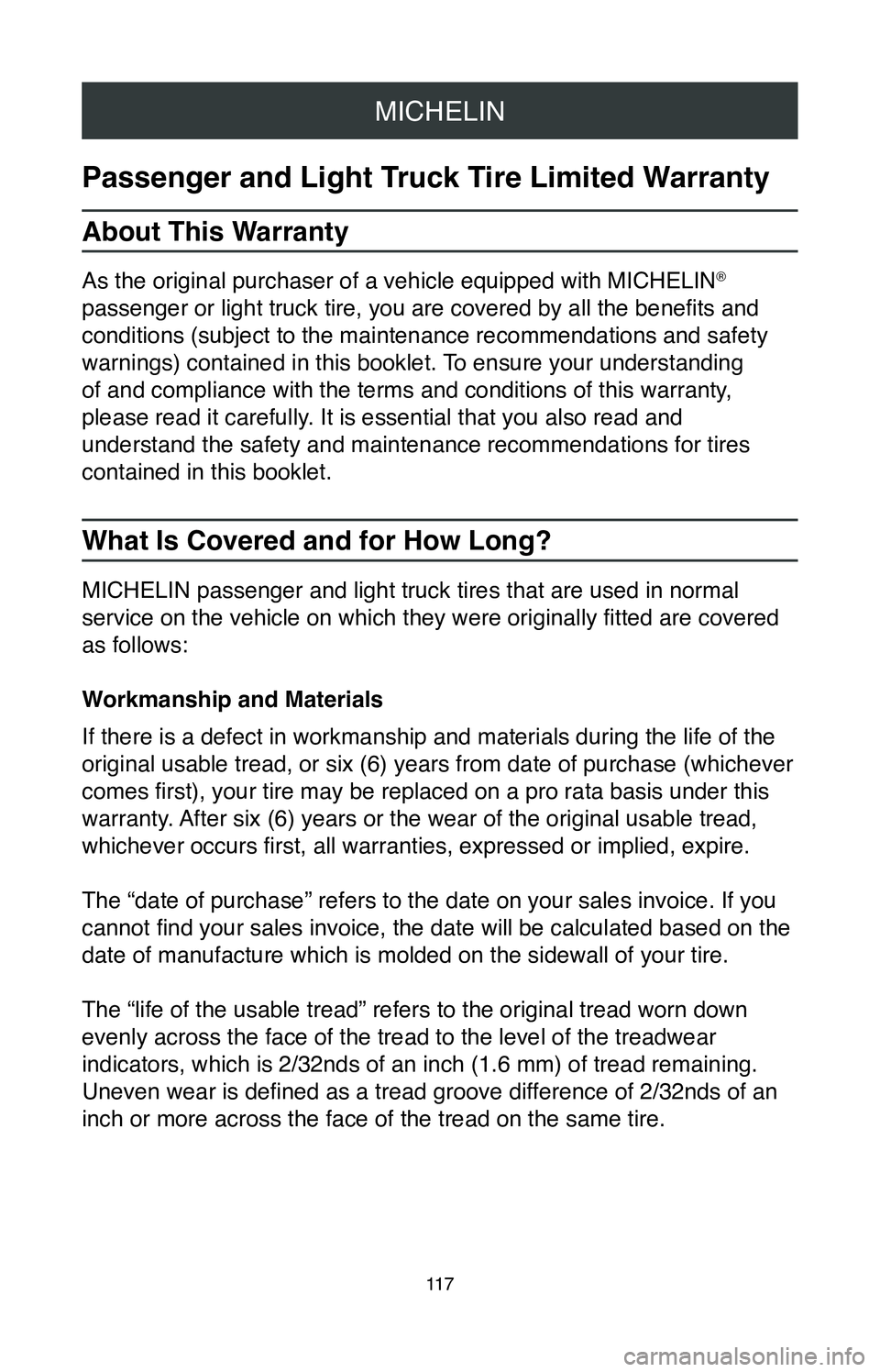
MICHELIN
11 7
Passenger and Light Truck Tire Limited Warranty
About This Warranty
As the original purchaser of a vehicle equipped with MICHELIN®
passenger or light truck tire, you are covered by all the benefits and
conditions (subject to the maintenance recommendations and safety
warnings) contained in this booklet. To ensure your understanding
of and compliance with the terms and conditions of this warranty,
please read it carefully. It is essential that you also read and
understand the safety and maintenance recommendations for tires
contained in this booklet.
What Is Covered and for How Long?
MICHELIN passenger and light truck tires that are used in normal
service on the vehicle on which they were originally fitted are covered
as follows:
Workmanship and Materials
If there is a defect in workmanship and materials during the life of the\
original usable tread, or six (6) years from date of purchase (whichever
comes first), your tire may be replaced on a pro rata basis under this
warranty. After six (6) years or the wear of the original usable tread,
whichever occurs first, all warranties, expressed or implied, expire.
The “date of purchase” refers to the date on your sales invoice. I\
f you
cannot find your sales invoice, the date will be calculated based on the
date of manufacture which is molded on the sidewall of your tire.
The “life of the usable tread” refers to the original tread worn d\
own
evenly across the face of the tread to the level of the treadwear
indicators, which is 2/32nds of an inch (1.6 mm) of tread remaining.
Uneven wear is defined as a tread groove difference of 2/32nds of an
inch or more across the face of the tread on the same tire.
Page 133 of 260
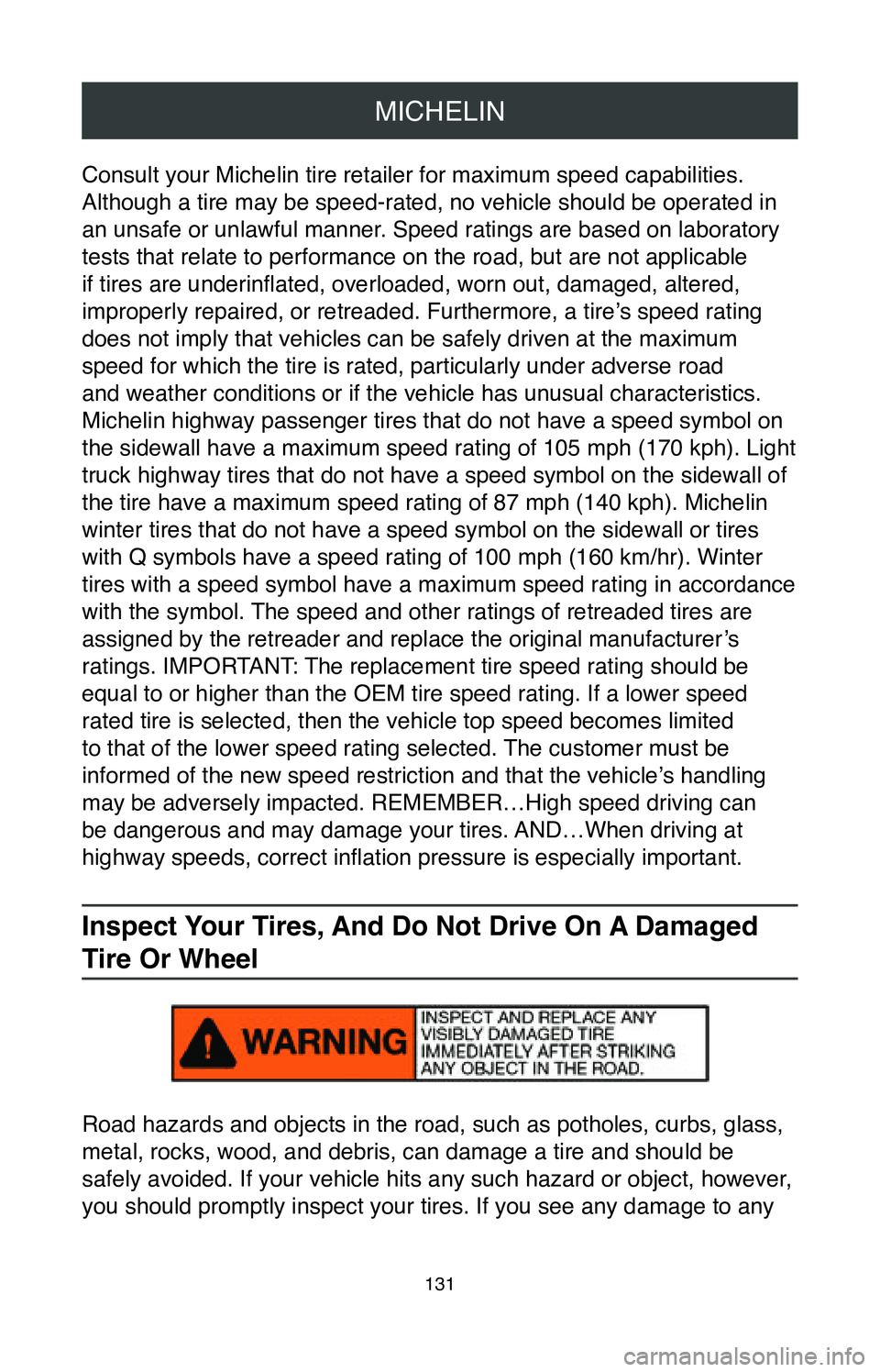
MICHELIN
131
Consult your Michelin tire retailer for maximum speed capabilities.
Although a tire may be speed-rated, no vehicle should be operated in
an unsafe or unlawful manner. Speed ratings are based on laboratory
tests that relate to performance on the road, but are not applicable
if tires are underinflated, overloaded, worn out, damaged, altered,
improperly repaired, or retreaded. Furthermore, a tire’s speed rating
does not imply that vehicles can be safely driven at the maximum
speed for which the tire is rated, particularly under adverse road
and weather conditions or if the vehicle has unusual characteristics.
Michelin highway passenger tires that do not have a speed symbol on
the sidewall have a maximum speed rating of 105 mph (170 kph). Light
truck highway tires that do not have a speed symbol on the sidewall of
the tire have a maximum speed rating of 87 mph (140 kph). Michelin
winter tires that do not have a speed symbol on the sidewall or tires
with Q symbols have a speed rating of 100 mph (160 km/hr). Winter
tires with a speed symbol have a maximum speed rating in accordance
with the symbol. The speed and other ratings of retreaded tires are
assigned by the retreader and replace the original manufacturer’s
ratings. IMPORTANT: The replacement tire speed rating should be
equal to or higher than the OEM tire speed rating. If a lower speed
rated tire is selected, then the vehicle top speed becomes limited
to that of the lower speed rating selected. The customer must be
informed of the new speed restriction and that the vehicle’s handling
may be adversely impacted. REMEMBER…High speed driving can
be dangerous and may damage your tires. AND…When driving at
highway speeds, correct inflation pressure is especially important.
Inspect Your Tires, And Do Not Drive On A Damaged
Tire Or Wheel
Road hazards and objects in the road, such as potholes, curbs, glass,
metal, rocks, wood, and debris, can damage a tire and should be
safely avoided. If your vehicle hits any such hazard or object, however,
you should promptly inspect your tires. If you see any damage to any
Page 140 of 260
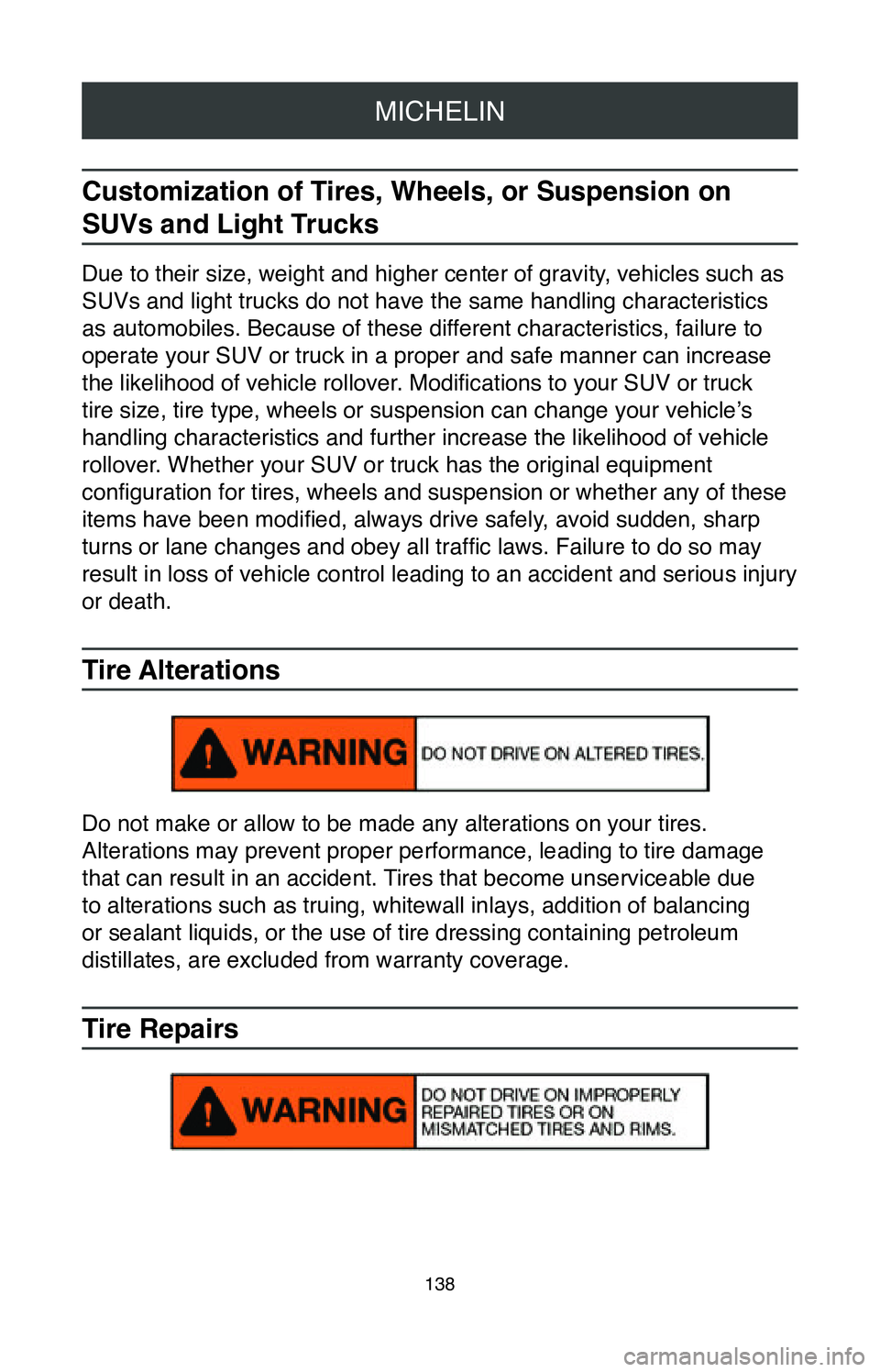
MICHELIN
138
Customization of Tires, Wheels, or Suspension on
SUVs and Light Trucks
Due to their size, weight and higher center of gravity, vehicles such as
SUVs and light trucks do not have the same handling characteristics
as automobiles. Because of these different characteristics, failure to
operate your SUV or truck in a proper and safe manner can increase
the likelihood of vehicle rollover. Modifications to your SUV or truck
tire size, tire type, wheels or suspension can change your vehicle’s
handling characteristics and further increase the likelihood of vehicle \
rollover. Whether your SUV or truck has the original equipment
configuration for tires, wheels and suspension or whether any of these
items have been modified, always drive safely, avoid sudden, sharp
turns or lane changes and obey all traffic laws. Failure to do so may
result in loss of vehicle control leading to an accident and serious injury
or death.
Tire Alterations
Do not make or allow to be made any alterations on your tires.
Alterations may prevent proper performance, leading to tire damage
that can result in an accident. Tires that become unserviceable due
to alterations such as truing, whitewall inlays, addition of balancing
or sealant liquids, or the use of tire dressing containing petroleum
distillates, are excluded from warranty coverage.
Tire Repairs
Page 141 of 260
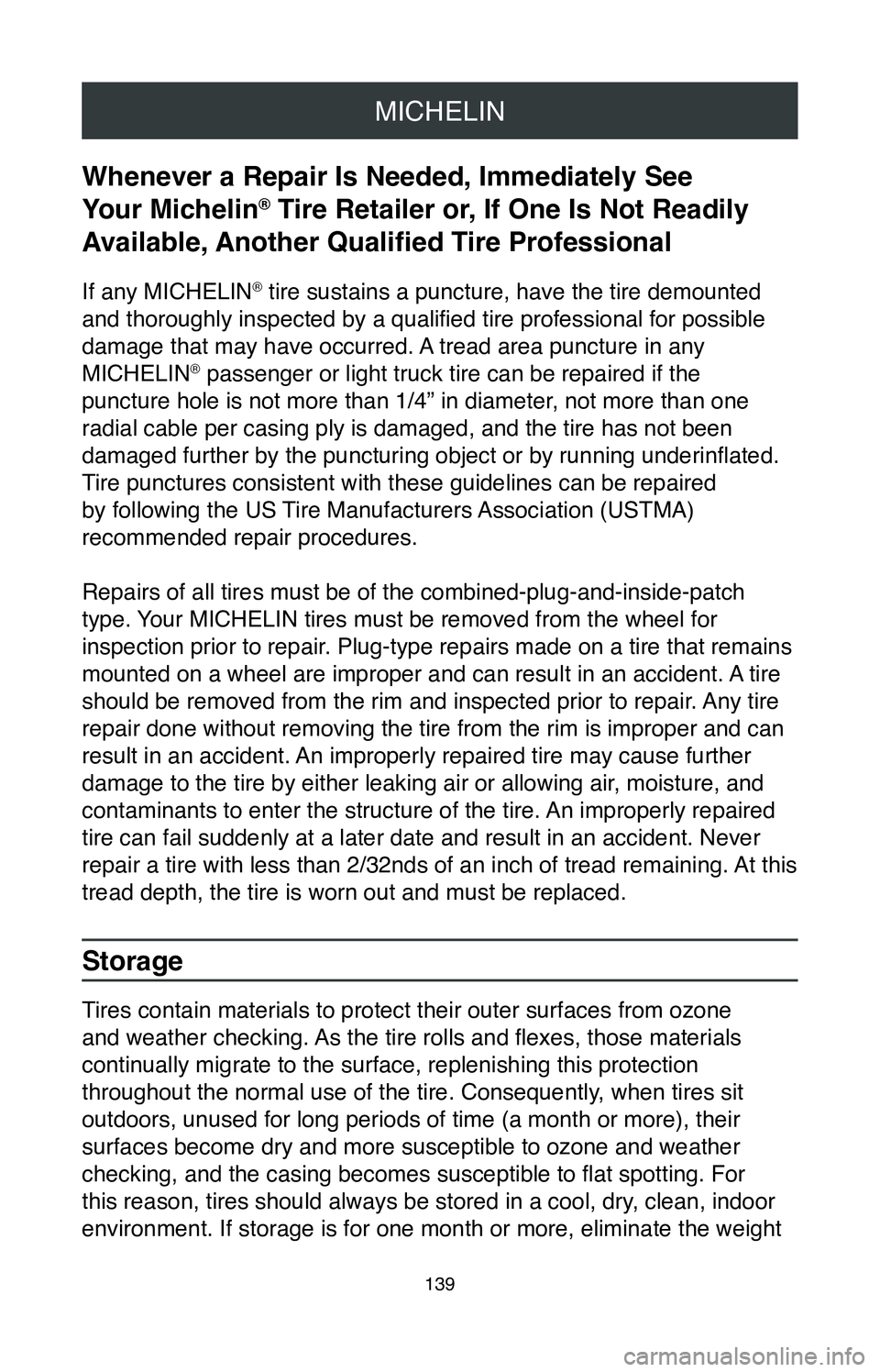
MICHELIN
139
Whenever a Repair Is Needed, Immediately See
Your Michelin
® Tire Retailer or, If One Is Not Readily
Available, Another Qualified Tire Professional
If any MICHELIN® tire sustains a puncture, have the tire demounted
and thoroughly inspected by a qualified tire professional for possible
damage that may have occurred. A tread area puncture in any
MICHELIN
® passenger or light truck tire can be repaired if the
puncture hole is not more than 1/4” in diameter, not more than one
radial cable per casing ply is damaged, and the tire has not been
damaged further by the puncturing object or by running underinflated.
Tire punctures consistent with these guidelines can be repaired
by following the US Tire Manufacturers Association (USTMA)
recommended repair procedures.
Repairs of all tires must be of the combined-plug-and-inside-patch
type. Your MICHELIN tires must be removed from the wheel for
inspection prior to repair. Plug-type repairs made on a tire that remains
mounted on a wheel are improper and can result in an accident. A tire
should be removed from the rim and inspected prior to repair. Any tire
repair done without removing the tire from the rim is improper and can
result in an accident. An improperly repaired tire may cause further
damage to the tire by either leaking air or allowing air, moisture, and
contaminants to enter the structure of the tire. An improperly repaired
tire can fail suddenly at a later date and result in an accident. Never \
repair a tire with less than 2/32nds of an inch of tread remaining. At this
tread depth, the tire is worn out and must be replaced.
Storage
Tires contain materials to protect their outer surfaces from ozone
and weather checking. As the tire rolls and flexes, those materials
continually migrate to the surface, replenishing this protection
throughout the normal use of the tire. Consequently, when tires sit
outdoors, unused for long periods of time (a month or more), their
surfaces become dry and more susceptible to ozone and weather
checking, and the casing becomes susceptible to flat spotting. For
this reason, tires should always be stored in a cool, dry, clean, indoor
environment. If storage is for one month or more, eliminate the weight
Page 144 of 260
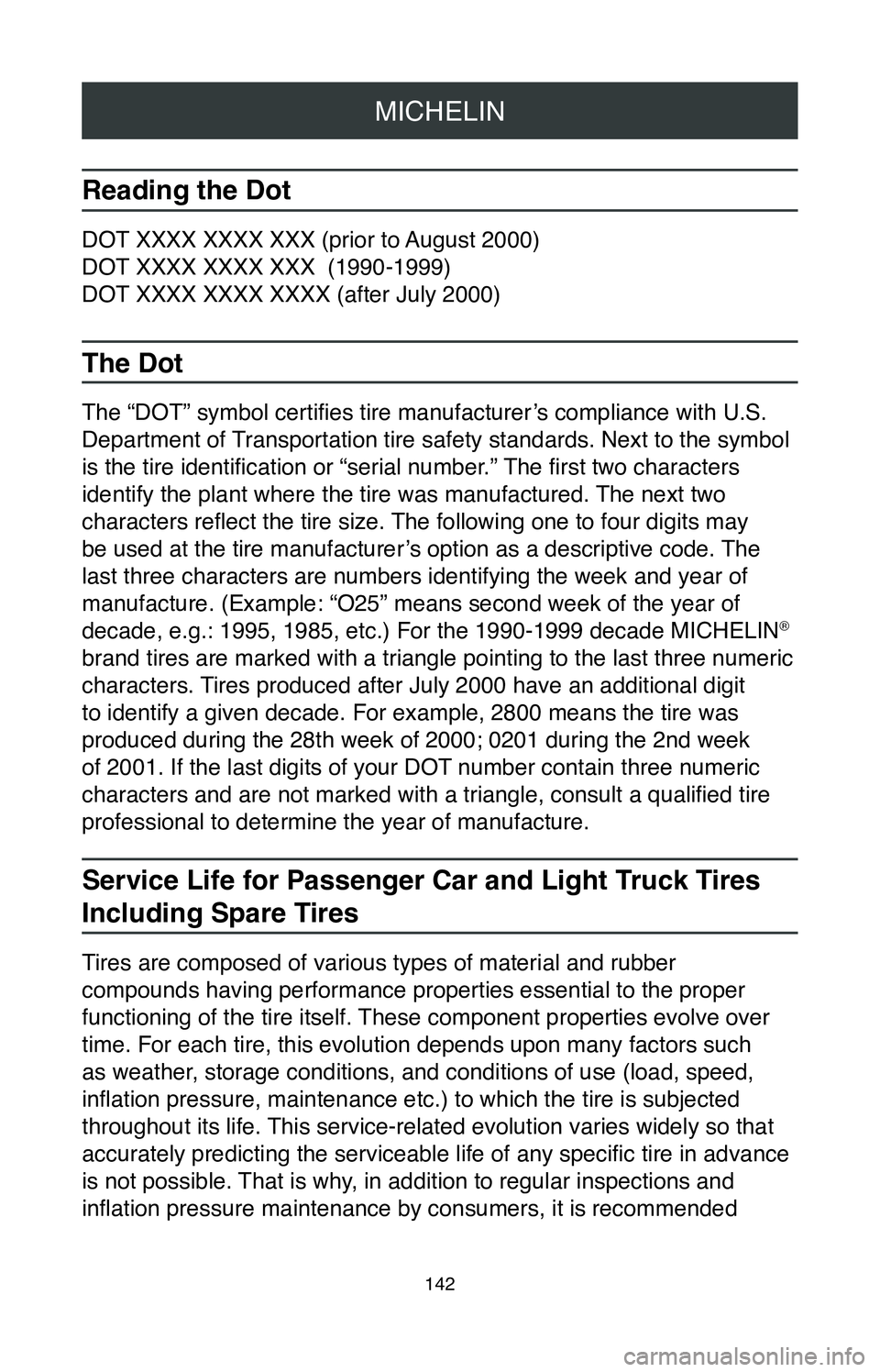
MICHELIN
142
Reading the Dot
DOT XXXX XXXX XXX (prior to August 2000)
DOT XXXX XXXX XXX
(1990-1999)
DOT XXXX XXXX XXXX (after July 2000)
The Dot
The “DOT” symbol certifies tire manufacturer’s compliance with U.S.
Department of Transportation tire safety standards. Next to the symbol
is the tire identification or “serial number.” The first two characters
identify the plant where the tire was manufactured. The next two
characters reflect the tire size. The following one to four digits may
be used at the tire manufacturer’s option as a descriptive code. The
last three characters are numbers identifying the week and year of
manufacture. (Example: “O25” means second week of the year of
decade, e.g.: 1995, 1985, etc.) For the 1990-1999 decade MICHELIN
®
brand tires are marked with a triangle pointing to the last three numeri\
c
characters. Tires produced after July 2000 have an additional digit
to identify a given decade. For example, 2800 means the tire was
produced during the 28th week of 2000; 0201 during the 2nd week
of 2001. If the last digits of your DOT number contain three numeric
characters and are not marked with a triangle, consult a qualified tire
professional to determine the year of manufacture.
Service Life for Passenger Car and Light Truck Tires
Including Spare Tires
Tires are composed of various types of material and rubber
compounds having performance properties essential to the proper
functioning of the tire itself. These component properties evolve over
time. For each tire, this evolution depends upon many factors such
as weather, storage conditions, and conditions of use (load, speed,
inflation pressure, maintenance etc.) to which the tire is subjected
throughout its life. This service-related evolution varies widely so that
accurately predicting the serviceable life of any specific tire in advance
is not possible. That is why, in addition to regular inspections and
inflation pressure maintenance by consumers, it is recommended
Page 145 of 260
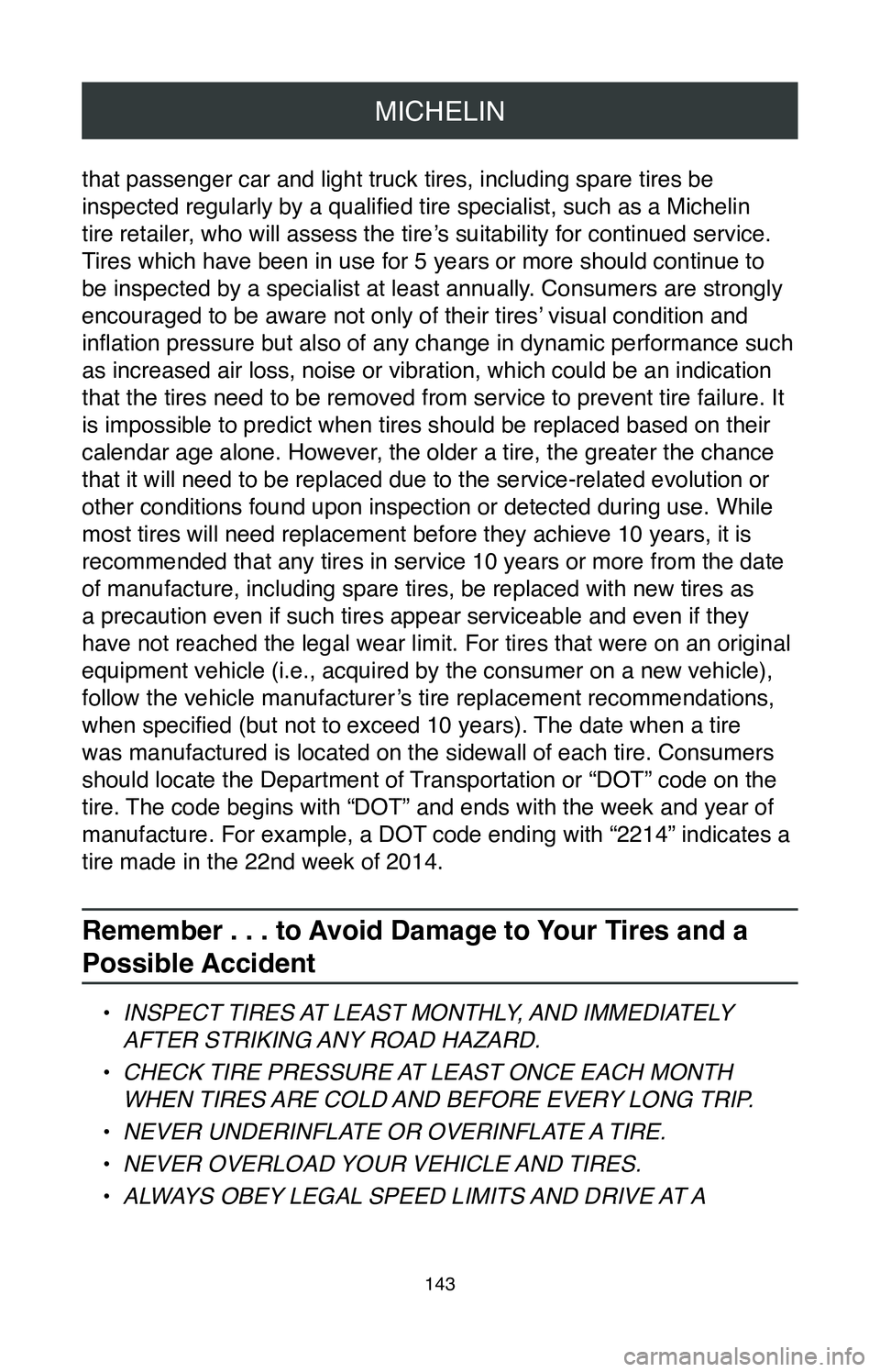
MICHELIN
143
that passenger car and light truck tires, including spare tires be
inspected regularly by a qualified tire specialist, such as a Michelin
tire retailer, who will assess the tire’s suitability for continued service.
Tires which have been in use for 5 years or more should continue to
be inspected by a specialist at least annually. Consumers are strongly
encouraged to be aware not only of their tires’ visual condition and
inflation pressure but also of any change in dynamic performance such
as increased air loss, noise or vibration, which could be an indication \
that the tires need to be removed from service to prevent tire failure. \
It
is impossible to predict when tires should be replaced based on their
calendar age alone. However, the older a tire, the greater the chance
that it will need to be replaced due to the service-related evolution or
other conditions found upon inspection or detected during use. While
most tires will need replacement before they achieve 10 years, it is
recommended that any tires in service 10 years or more from the date
of manufacture, including spare tires, be replaced with new tires as
a precaution even if such tires appear serviceable and even if they
have not reached the legal wear limit. For tires that were on an origina\
l
equipment vehicle (i.e., acquired by the consumer on a new vehicle),
follow the vehicle manufacturer’s tire replacement recommendations,
when specified (but not to exceed 10 years). The date when a tire
was manufactured is located on the sidewall of each tire. Consumers
should locate the Department of Transportation or “DOT” code on the
tire. The code begins with “DOT” and ends with the week and year of
manufacture. For example, a DOT code ending with “2214” indicates a
tire made in the 22nd week of 2014.
Remember . . . to Avoid Damage to Your Tires and a
Possible Accident
• INSPECT TIRES AT LEAST MONTHLY, AND IMMEDIATELY
AFTER STRIKING ANY ROAD HAZARD.
•
CHECK TIRE PRESSURE AT LEAST ONCE EACH MONTH
WHEN TIRES ARE COLD AND BEFORE EVERY LONG TRIP.
•
NEVER UNDERINFLATE OR OVERINFLATE A TIRE.
•
NEVER OVERLOAD YOUR VEHICLE AND TIRES.
•
ALWAYS OBEY LEGAL SPEED LIMITS AND DRIVE AT A
Page 148 of 260
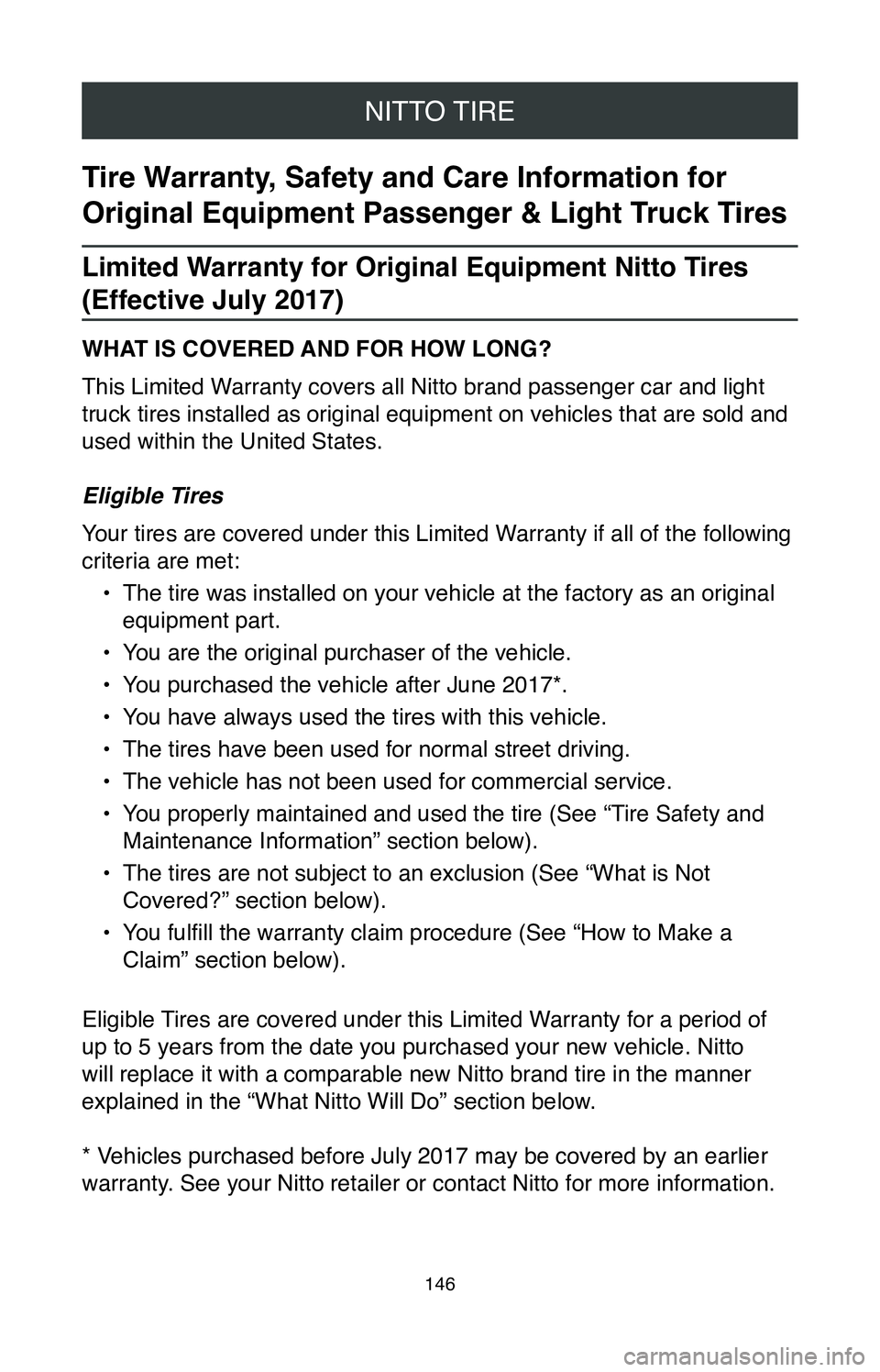
NITTO TIRE
146
Tire Warranty, Safety and Care Information for
Original Equipment Passenger & Light Truck Tires
Limited Warranty for Original Equipment Nitto Tires
(Effective July 2017)
WHAT IS COVERED AND FOR HOW LONG?
This Limited Warranty covers all Nitto brand passenger car and light
truck tires installed as original equipment on vehicles that are sold an\
d
used within the United States.
Eligible Tires
Your tires are covered under this Limited Warranty if all of the following
criteria are met:•
The tire was installed on your vehicle at the factory as an original
equipment part.
•
You are the original purchaser of the vehicle.
•
You purchased the vehicle after June 2017*.
•
You have always used the tires with this vehicle.
•
The tires have been used for normal street driving.
•
The vehicle has not been used for commercial service.
•
You properly maintained and used the tire (See “Tire Safety and
Maintenance Information” section below).
•
The tires are not subject to an exclusion (See “What is Not
Covered?” section below).
•
You fulfill the warranty claim procedure (See “How to Make a
Claim” section below).
Eligible Tires are covered under this Limited Warranty for a period of
up to 5 years from the date you purchased your new vehicle. Nitto
will replace it with a comparable new Nitto brand tire in the manner
explained in the “What Nitto Will Do” section below.
* Vehicles purchased before July 2017 may be covered by an earlier
warranty. See your Nitto retailer or contact Nitto for more information.